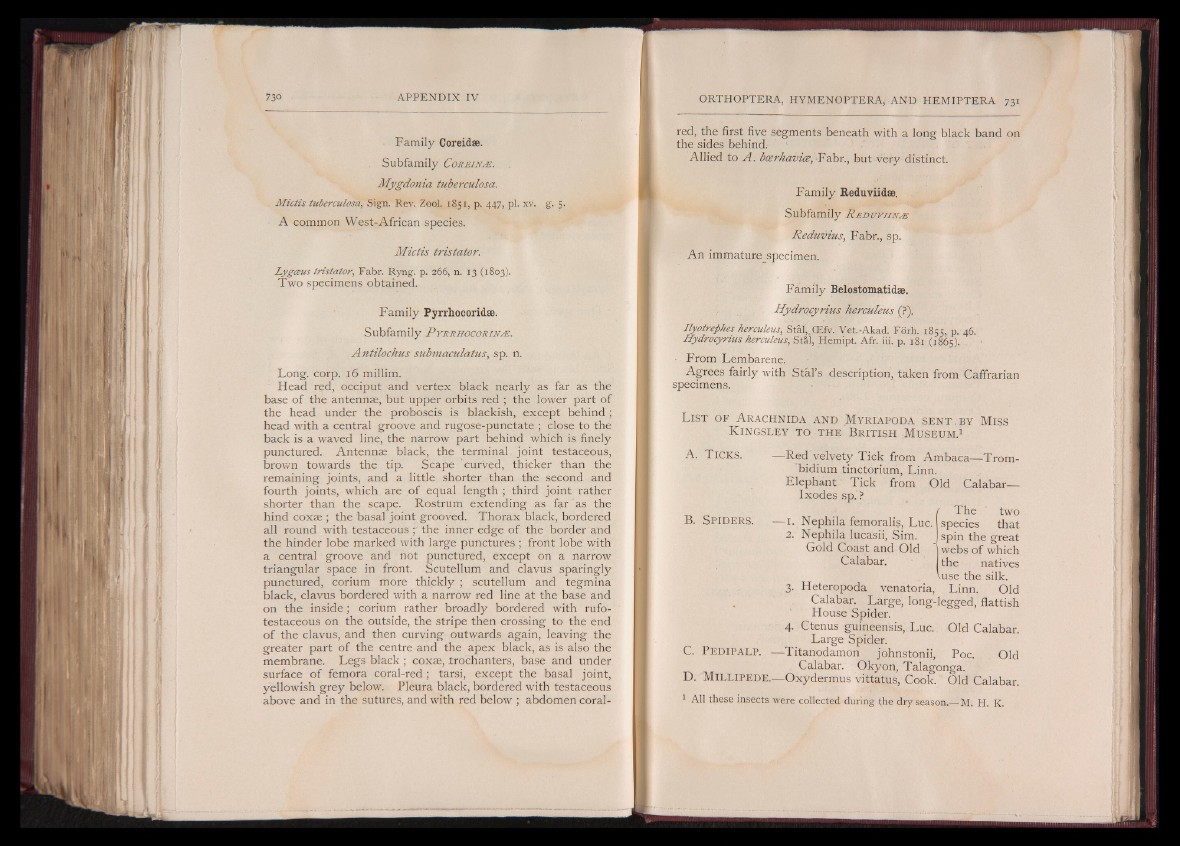
Family Coreidse.
Subfamily C o r e i n m .
Mygdonia tuberculosa.
Mictis tuberculosa, Sign. Rev. Zool. 1851, p. 447, pi. xv. g. 5.
A common West-African species.
Mictis tristator.
Lygceus tristator, Fabr. Ryng. p. 266, n. 13 (1803).
Two specimens obtained.
Family Pyrrhocoridae.
Subfamily P y r r h o c o r i n m .
Antilochus submaculatus, sp. n.
Long. corp. 16 millim.
Head red, occiput and vertex black nearly as far as the
base of the antennae, but upper orbits red ; the lower part of
the head under the proboscis is blackish, except behind ;
head with a central groove and rugose-punctate ; close to the
back is a waved line, the narrow part behind which is finely
punctured. Antennae black, the terminal joint testaceous,
brown towards the tip. Scape curved, thicker than the
remaining joints, and a little shorter than the second and
fourth joints, which are of equal length ; third joint rather
shorter than the scape. Rostrum extending as far as the
hind coxae ; the basatl joint grooved. Thorax black, bordered
all round with testaceous f the inner edge of the border and
the hinder lobe marked with large punctures; front lobe with
a central groove and not punctured, except on a narrow
triangular space in front. Scutellum and clavus sparingly
punctured, corium more thickly ; scutellum and tegmina
black, clavus bordered with a narrow red line at the base and
on the inside; corium rather broadly bordered with rufo-
testaceous on the outside, the stripe then crossing to the end
of the clavus, and then curving outwards again, leaving the
greater part of the centre and the apex black, as is also the
membrane. Legs black ; coxae, trochanters, base and under
surface of femora coral-red ; tarsi, except the basal joint,
yellowish grey below. Pleura black, bordered with testaceous
above and in the sutures, and with red below ; abdomen coralred,
the first five segments beneath with a long black band on
the sides behind.
Allied to A. bcerhavice, Fabr., but very distinct.
Family Reduviidse.
Subfamily Reduviinm '
Reduvius, Fabr., sp.
An immature specimen.
Family Belostomatidae.
Hydrocyrius herculeus (?).
Ilyotrephes herculeus, Stal,.GEfv. Vet.-Akad. Forh. 1855, p. 46.
Hydrocyrius herculeus, Stal, Hemipt. Afr. iii. p. 181 (1865). -
■ From Lembarene.
Agrees fairly with Stal’s description, taken from Caffrarian
specimens.
L i s t o f A r a c h n id a a n d M y r ia p o d a s e n t . b y M is s
K in g s l e y t o t h e B r i t i s h M u s e u m .1
A. TICKS. — Red velvety Tick from Ambaca— Trombidium
tinctorium, Linn.
Elephant Tick from Old Calabar—
Ixodes sp. ?
' V - I I The ' two
B. SPIDERS. ■— I. Nephila femoralis, Luc. species that
2. Nephila lucasii, Sim. I spin the great
Gold Coast and Old webs of which
Calabar. the natives
Vuse the silk.
3. Heteropoda venatoria, Linn. Old
Calabar. Large, long-legged, flattish
House Spider.
4. Ctenus guineensis, Luc. Old Calabar.
Large Spider.
C. P e d i p a l p . — Titanodamon johnstonii, Poe. Old
Calabar. Okyon, Talagonga.
D. M i l l i p e d e .— Oxydermus vittatus, Cook. Old Calabar.
1 All these insects were collected during the dry season.— M. H. K.